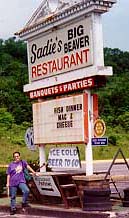I felt a moment’s temptation to try and go see Mary Oliver. But what if she’s a twit? It was rather upsetting when I went to hear Margaret Atwood, though we’re all ambivalent about her these days for being a snotwad about science fiction some of the time, I still have my admirations… and she was cool, but came off as oddly stuckup for someone who is so boasty about growing up in the backwoods.
Anyway I have this nightmare-universe vision suddenly of Oliver being so eastcoast and upperclass that I will want to scream no matter how much i like her poetry. It’s so unfair to say this; I know nothing about her!
Considering imitations. People who try to write like Oliver, they bother me more than people who try to write like Ginsberg. Why is that? Certain literary styles that are good in the original but when the emulators spring up, it makes it all seem cheap.
And I imitate her too including the yuppie moments of aetheticization and thoreau-like musing combined and the neat little wrap-up at the end. Sometimes I write that kind of poem and then I’m disgusted with myself. And then i know someone will publish it somewhere because it is easy to grok. It’s simple and digestible. And then I feel dirty, a lowdown rotten dirty liar, because my moment of aestheticizing nature is essentially false given the way I live, in an urban/suburban environment, so that it’s like this blinder-vision where I’m staring as if hypnotized at a tree or an acorn or a star, when all around me are streets and houses, bags of cheetos, paperclips, trashcans, dinner tables, people going to work. If I were actually living out in the woods like Thoreau it would seem more intellectually honest to write about the tree like it were the most important thing in my world. (Though I read all about how Thoreau’s mom or aunt or someone would come and clean his house and bring him his dinner so he could loll about the trails gazing at groundhogs — so he’s rather bogus himself.)
This is not at all a new thought for me; I became obsessed with it when I was about 16 and I set out to try to aestheticize everything and ended up with a lot of that sort of poetry that exalts paperclips and trashcans to positions of tawdry glory. At that age I was filled with a lot of wild determinations like, “I’m going to combine Art and Science in a way heretofore never seen in the history of the entire world!”
And later I tried to feel a spiritual & poetic bond while musing on the nature of the artificial, the spirit of manufactured objects and mass production. I can get in that mode where an empty milk carton is a tragic miracle! The effort required to make it, its moldedness, its nearly severed connection with the things used to make it and with people. But central nature-y things come up, or one is just too conditioned to go around “feeling poetic” when the moon is up, or when gazing at the ocean with no pressure to go anywhere, and the moon and stars become poetic archetypes, part of a pantheon of symbology, and the trashcans, paperclips, urbanness, etc. are harder to internalize. And then one doubts completely whether the aestheticization of everything is a good idea at all! If we accept that poetic musing as part of the process of art or the point of art, then we’re lost to poltitical awareness.
So, back to the small precious illusions about other poets: Part of the reason I can believe in Marge Piercy’s poems is that I believe in the picture of her I have constructed, that she spends a lot of time in her garden, that she has a huge real-life commitment to composting her lettuce beds. I imagine her recycling everything, and wearing only all-cotton tunic-dresses made by non-sweatshop labor, and you know, the salty Cape Cod wind blowing in her hair. And it kinda ruins it when I imagine her going to K-mart and buying some socks, tampax, and a bag of cheetos and going home to eat the cheetos, grumpily pop some Midol, and watch Tivo-ed episode of “Cops” until she falls asleep in front of the TV, even though surely that or its Marge Piercy equivalent must happen. How unfair that my romantic myth of the poet should interfere with the poetry itself! And that the poetry should construct this unrealistic wind-blown portrait of the poet! Is that really necessary? I don’t think it’s right!
At poetry readings, part of what we like about them as poets — I’m thinking of Waverley Writers here, or some other small “page poet” readings around the Bay Area — is that we see evidence of other people who seem like regular cheeto-consuming people, confessing to those moments of tender aestheticization, of romanticizing some aspect of the world. And that makes them vulnerable, I think, and we mutually recognize the vulnerability of “being like that” and walking around in a sort of fog where we attach our attention to some object– or situation –and stuff all this meaning into it. We’re a little embarrassed. And yet we love it – and admire it when other people do it, no matter how it may seem to the rest of the world like pointless navel-gazing wankery.
